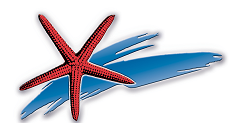Puffinus diomedea
Family: Procellariidae
Length: 45 – 56 cm
Wingspan: 110 – 125 cm
Weight: 550 – 740 g

Identification
Appearance: medium-sized, contrasted back (brown to grey-brown) and belly (white), fine yellow beak (light coloured at the base and dark at its extremity) with tubular nostrils and marked angle with the head, pink webbed feet.
Distinguishing characteristics: less contrasted, more massive, darker flanks, angle head/beak less marked than Yelkouan and Balearic Shearwater.
Flight: flies lazily on arched wings and performs slow wingbeats.
Sound: silent at sea but vocal at colonies, calls both in flight and from the ground. The female’s voice is lower-pitched. The main call is a harsh, snoring, repeated wail “keeowwrrah-keeowwrrah”.
Ecology and habitat
Nest: burrows, rock crevices or natural hollows, on the ground under the vegetation, under roots or in artificial sites (holes in walls) on cliffs, in caves, boulder fields or inland on rocky slopes.
Diet: fish, squids, crustaceans, zooplankton, discards from fishing boats. Behaviour at sea: they can form large flocks, particularly when they feed in assocation with predators (marine mammals and tuna) that drive the preys close to the surface. They form huge « rafts » at sea just before coming ashore to their breeding sites at night during dusk and just after departing their breeding colonies at dawn.
* This map indicates coastal nesting sites in the Mediterranean and adjacent Seas.
Distribution and movement
Breeding: across the Mediterranean: in the Balearics, Iles d’Hyères (France), on Italian islands, in Malta, on Croatian islands (and parts of the mainland), Zembra Island (Tunisia), and Greek islands.
Wintering: adults leave their Mediterranean breeding grounds in October and exit into Atlantic Ocean and move rapidly southwards. Most populations spend the winter in East Atlantic Ocean and move south in areas off the West coast of Africa and the East coast of Brazil. Other birds may reach South Africa and Indian Ocean, or just winter in the Mediterranean.
Phenology: arrival to the colony: end of February. Breeding season starts in April, with laying in late May/early June. Incubation: about 52 days (both adults take care of a single egg). Brooding: parents attend the nest frequently to feed the chick. Fledging: about 89 days after hatching. Sexual maturity is reached after 4-5 years.
Conservation
Global population estimate: 141,000 – 223,000 pairs. The species is widespread and abundant accross its range, but appears to be declining.
Threats: fishery bycatch, introduced predators (rats, cats), mortality induced by urban lights, hunting and egg-harvesting, marine pollution.
Protection level: Barcelona Convention : Annex II; Bern Convention : Annex II; Birds Directive : Annex I; IUCN Red List: Least Concern.
Some key references
Anselme L & Durand JP (2012) The Cory’s Shearwater Calonectris diomedea diomedea, Updated state of knowledge and conservation of the nesting populations of the small Mediterranean islands. Initiative PIM. 23p.
Ramos R. (2019) Crossing the Pillars of Hercules: Understanding transoceanic migrations of seabirds throughout their breeding range. Ecology and evolution 9(8): 4760-4771.
du Rau PD et al. (2015) Reassessment of the size of the Scopoli’s Shearwater population at its main breeding site resulted in a tenfold increase: implications for the species conservation. Journal of Ornithology, 156(4), 877-892.
Flood R & Gutiérrez R (2019) Status of Cory’s Shearwater in the western Mediterranean. Dutch Birding, 41: 159-165.
